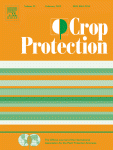Ver ítem
- xmlui.general.dspace_homeCentros Regionales y EEAsCentro Regional Buenos Aires SurEEA BarrowArtículos científicosxmlui.ArtifactBrowser.ItemViewer.trail
- Inicio
- Centros Regionales y EEAs
- Centro Regional Buenos Aires Sur
- EEA Barrow
- Artículos científicos
- Ver ítem
Glyphosate resistance in perennial ryegrass (Lolium perenne L.) from Argentina
Resumen
In Argentina, glyphosate is the most widely used herbicide. A population of perennial ryegrass, subjected to two glyphosate applications per year during twelve years, was putatively identified as glyphosate-resistant based on the poor control achieved at commercial glyphosate doses. The aim of the current research was to evaluate the sensitivity to glyphosate of the offspring of the putatively resistant population. A susceptible population was included as
[ver mas...]
In Argentina, glyphosate is the most widely used herbicide. A population of perennial ryegrass, subjected to two glyphosate applications per year during twelve years, was putatively identified as glyphosate-resistant based on the poor control achieved at commercial glyphosate doses. The aim of the current research was to evaluate the sensitivity to glyphosate of the offspring of the putatively resistant population. A susceptible population was included as control to assess germination, chlorophyll content, survival, and shikimic acid concentration under different glyphosate treatments. After glyphosate treatment, the germination percentage and plumule growth were significantly higher in the putatively resistant population compared to the susceptible one. Relative to the non-treated control, resistant seedlings did not show differences in chlorophyll content 7d and 10d post-application regardless of glyphosate treatments. In the resistant plants, a 10.8-fold greater dose of glyphosate was necessary to match the control efficiency on the susceptible ones. At 30d post-application, 40% of the resistant plants that were severely injured at 15 days started re-growth regardless of glyphosate dose. Leaf laminae of susceptible plants accumulated significantly higher shikimic acid compared to the resistant plants at 72 h post-application.
[Cerrar]

Autor
Yanniccari, Marcos Ezequiel;
Istilart, Carolina Maria;
Gimenez, Daniel Oscar;
Castro, Ana Maria;
Fuente
Crop protection 32 : 12-16. (February 2012)
Fecha
2012-02
ISSN
0261-2194
Formato
pdf
Tipo de documento
artículo
Palabras Claves
Derechos de acceso
Restringido
 Excepto donde se diga explicitamente, este item se publica bajo la siguiente descripción: Creative Commons Attribution-NonCommercial-ShareAlike 2.5 Unported (CC BY-NC-SA 2.5)
Excepto donde se diga explicitamente, este item se publica bajo la siguiente descripción: Creative Commons Attribution-NonCommercial-ShareAlike 2.5 Unported (CC BY-NC-SA 2.5)

